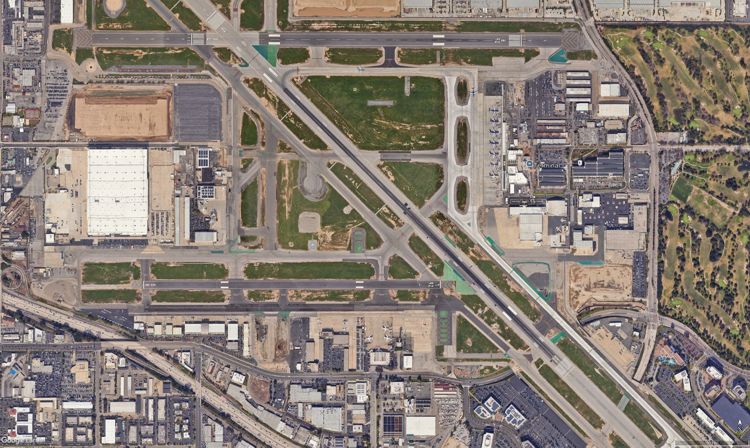A Hawaiian Airlines Airbus A321-200N, registration N216HA performing flight HA-70 from Honolulu,HI to Long Beach,CA (USA), was cleared to land on runway 30.
At the same time a private Cessna 172 was cleared to land on runway 26L, the final approach path crossing runway 30 about 500 meters/1640 feet down runway 30.
The NTSB reported the two aircraft were involved in a near mid air collision "over the point where runway 30 and the final approach path for runway 26L intersect" and released their final report concluding the probable cause of the incident were:
The local controllers poor judgment in prioritization of their ground traffic ahead of their airborne traffic, that became a distraction and led to a loss of situational awareness resulting in a near midair collision. Contributing to the incident was the controller in charges ineffective oversight.
The NTSB analysed:
Hawaiian Airlines flight 70 (HAL70), N2165HA, an Airbus A321, and a Textron Aviation, Inc. C172N, N24CV, were involved in a near mid air collision (NMAC) over the point where runway 30 and the final approach path for runway 26L intersect at Long Beach (Daugherty Field) Airport (LGB).
At the time of the incident, the local control 1 (LC1), local assist, and ground control positions were combined to the LC1 position in the LGB air traffic control tower and staffed by a single certified professional controller. According to ATC transcripts and a post-- event interview, the LC1 controller turned N24CV on a base leg to runway 26L and cleared N24CV to land on 26L when the aircraft was approximately one mile from the runway. About this same time, the LC1 controller also cleared HAL70 to land on runway 30, when the flight was on a four-mile final.
The LC1 controller did not realize that N24CV continued another half mile before starting their base turn, an event which led to both aircraft arriving at the airport at nearly the same time. In the three minutes leading to the incident, the LC1 controller received multiple calls on the ground control frequency from aircraft requesting push-back. He also initiated a call to the Traffic Management Unit (TMU) to request a release for another aircraft. These events distracted the LC1 controller from the local control operation at the time of the incident. This duty prioritization was not consistent with guidance contained in FAA Order JO 7110.65AA, Air Traffic Control, 2-1-1, ATC Service and 2-10-3, Tower Team Position Responsibilities.
The controller in charge (CIC) stated in the post event interview that he heard the LC1 controller calling TMU for the release and said he should have made the call instead, and this was a failure on his part. This would have allowed the LC1 controller to concentrate on traffic.
The CIC also stated he was not actively monitoring the LC1 controller frequencies and stated he should have been a second set of eyes for the LC1 controller. This was not consistent with guidance contained in the LGB7110.3G SOP, Chapter 3-1-1, Clearance Delivery, Chapter 7-1-1, Front Line Manger/Controller in Charge and 7-2-1, subsection f.
Map (Graphics: Google Earth):

At the same time a private Cessna 172 was cleared to land on runway 26L, the final approach path crossing runway 30 about 500 meters/1640 feet down runway 30.
The NTSB reported the two aircraft were involved in a near mid air collision "over the point where runway 30 and the final approach path for runway 26L intersect" and released their final report concluding the probable cause of the incident were:
The local controllers poor judgment in prioritization of their ground traffic ahead of their airborne traffic, that became a distraction and led to a loss of situational awareness resulting in a near midair collision. Contributing to the incident was the controller in charges ineffective oversight.
The NTSB analysed:
Hawaiian Airlines flight 70 (HAL70), N2165HA, an Airbus A321, and a Textron Aviation, Inc. C172N, N24CV, were involved in a near mid air collision (NMAC) over the point where runway 30 and the final approach path for runway 26L intersect at Long Beach (Daugherty Field) Airport (LGB).
At the time of the incident, the local control 1 (LC1), local assist, and ground control positions were combined to the LC1 position in the LGB air traffic control tower and staffed by a single certified professional controller. According to ATC transcripts and a post-- event interview, the LC1 controller turned N24CV on a base leg to runway 26L and cleared N24CV to land on 26L when the aircraft was approximately one mile from the runway. About this same time, the LC1 controller also cleared HAL70 to land on runway 30, when the flight was on a four-mile final.
The LC1 controller did not realize that N24CV continued another half mile before starting their base turn, an event which led to both aircraft arriving at the airport at nearly the same time. In the three minutes leading to the incident, the LC1 controller received multiple calls on the ground control frequency from aircraft requesting push-back. He also initiated a call to the Traffic Management Unit (TMU) to request a release for another aircraft. These events distracted the LC1 controller from the local control operation at the time of the incident. This duty prioritization was not consistent with guidance contained in FAA Order JO 7110.65AA, Air Traffic Control, 2-1-1, ATC Service and 2-10-3, Tower Team Position Responsibilities.
The controller in charge (CIC) stated in the post event interview that he heard the LC1 controller calling TMU for the release and said he should have made the call instead, and this was a failure on his part. This would have allowed the LC1 controller to concentrate on traffic.
The CIC also stated he was not actively monitoring the LC1 controller frequencies and stated he should have been a second set of eyes for the LC1 controller. This was not consistent with guidance contained in the LGB7110.3G SOP, Chapter 3-1-1, Clearance Delivery, Chapter 7-1-1, Front Line Manger/Controller in Charge and 7-2-1, subsection f.
Map (Graphics: Google Earth):

This article is published under license. Article Source
Published Date















